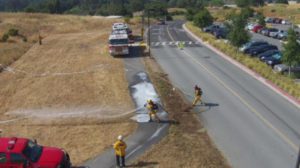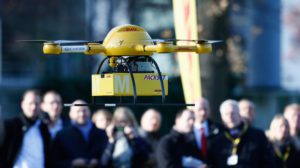Harnessing the Power of Drones for Solar Panel Inspections:
A Revolution in Efficiency and Precision
Written by Richard Armstrong – 1UP Drones Software Engineer & Drone Expert – Aug 2024
In the rapidly expanding world of renewable energy, solar power stands at the forefront of sustainable solutions. Yet, with this growth comes an often overlooked challenge: maintaining and optimizing the efficiency of large-scale solar installations. Drones, equipped with advanced imaging and data processing capabilities, are revolutionizing the way we inspect and maintain solar panels, ensuring that every ray of sunlight is harnessed to its fullest potential. The era of labor-intensive, costly, and time-consuming inspections is over; with drone technology, solar panel inspections are now faster, safer, and more accurate, offering unparalleled value and return on investment.
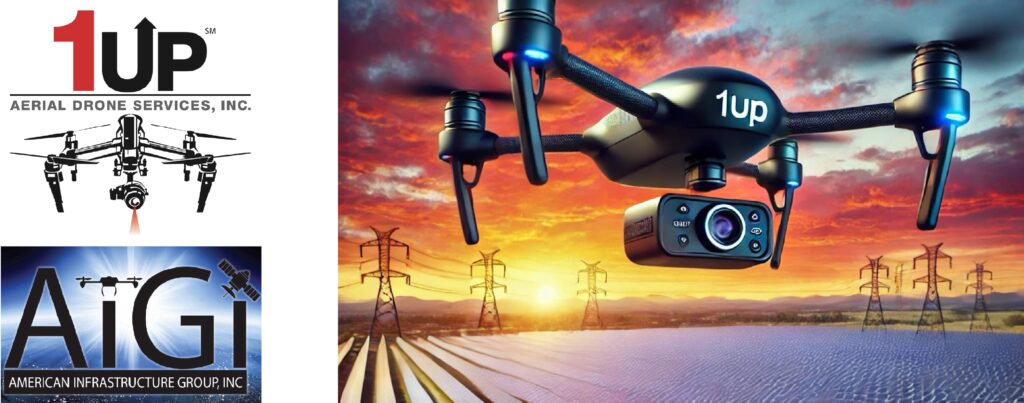
Reference: Drone technology has already been shown to reduce inspection costs by 30-40%, significantly boosting the ROI for solar utility companies by reducing labor costs and inspection times.
ROI and Cost Efficiency: Drone-Based Solar Panel Inspections
For owners and operators of solar utilities, maximizing the efficiency of their installations is crucial. Every hour a solar panel is underperforming due to debris, damage, or malfunction translates to lost revenue. Traditional inspection methods often involve manual checks that are both time-consuming and prone to human error. In contrast, drones can cover vast areas of solar panels in a fraction of the time, providing high-resolution thermal and visual imagery that can identify even the smallest issues before they escalate.
1UP Drones offers a comprehensive drone inspection service that not only pinpoints issues with remarkable accuracy but also provides actionable insights through advanced analytics. By leveraging AI-driven software, our drones can analyze vast amounts of data in real time, detecting anomalies such as hot spots, micro-cracks, and dirt accumulation that could go unnoticed during manual inspections. This level of detail ensures that operators can take immediate corrective action, reducing downtime and maintaining optimal energy production.
Reference: In a case study, drone inspections saved a solar farm in Arizona nearly $500,000 annually by identifying significant anomalies early, which would have led to substantial production losses if left undetected.
The return on investment is clear: drone inspections reduce operational costs by minimizing manual labor, decrease the risk of human error, and ensure that solar installations are operating at peak efficiency. Over time, this translates to significant savings and increased profitability for solar energy providers.
Maximizing ROI with Drone-Based Solar Panel Inspections
For utility companies managing large-scale solar installations, the ROI from drone-based inspections can be substantial. The ability to quickly and accurately identify issues that affect solar panel performance leads to significant cost savings and enhanced energy production. For example, a 100 MW solar farm that switches to drone-based inspections could save hundreds of thousands annually in reduced labor costs and increased energy output.
Expected ROI from Drone Inspections
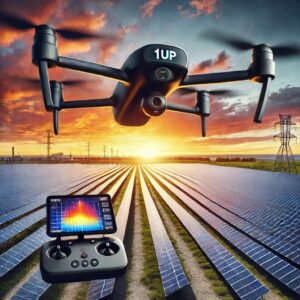
- Reduced Inspection Costs: Traditional manual inspections require substantial manpower, equipment, and time. With drones, a utility company can reduce these costs by up to 50-70%. Drones can cover large areas in a fraction of the time it takes for manual inspections, requiring fewer personnel and eliminating the need for expensive safety equipment.
- Minimized Downtime: Solar panels need to be operational as much as possible to maximize energy production. Drones can perform inspections more frequently and with greater accuracy, identifying issues before they lead to significant downtime. By addressing problems early, utility companies can maintain a higher level of productivity, leading to increased revenue from consistent energy output.
Reference: Industry studies suggest that bi-annual drone inspections over five years can save a 100 MW solar farm more than $19,000 in labor costs alone.
- Increased Panel Efficiency: Drones equipped with thermal and multispectral cameras can detect minute temperature variations and other anomalies that are indicative of underperforming panels. By identifying these panels early and conducting timely maintenance, utility companies can ensure that their entire solar farm operates at peak efficiency. This optimization can lead to an increase in overall energy output, boosting ROI by as much as 5-10%.
- Prolonged Asset Lifespan: Early detection of issues such as micro-cracks, soiling, or potential electrical failures allows for prompt repairs, which can extend the lifespan of solar panels. Prolonging the effective life of these assets delays the need for costly replacements, further enhancing ROI.
Resolving Pain Points: Speed, Safety, and Accuracy
The traditional methods of solar panel inspection involve significant risks and challenges. Technicians often have to navigate treacherous terrains, climb onto rooftops, or deal with the scorching heat of solar farms to inspect panels manually. These inspections are not only dangerous but also limited in their scope and accuracy.
Drones eliminate these risks by providing a bird’s-eye view of the entire installation. With advanced GPS and automation, drones can fly pre-programmed routes, ensuring that every panel is inspected consistently and thoroughly. This reduces the need for technicians to physically interact with the panels, significantly lowering the risk of injury.
Moreover, the speed at which drones can operate is unmatched. A manual inspection of a large solar farm could take days or even weeks, whereas a drone can complete the same task in just a few hours. This rapid turnaround time is crucial for maintaining the efficiency of solar installations, especially in industries where downtime can be costly.
Reference: A 75 MW, 500-acre facility can be inspected using drones in about a week, whereas traditional methods might take around a month. This time savings enables faster data analysis and decision-making.
The accuracy of drone inspections is another game-changer. Equipped with high-resolution cameras and thermal imaging sensors, drones can detect issues that are invisible to the naked eye. Thermal imaging, in particular, is invaluable for identifying hot spots, which are often precursors to more serious problems. By catching these issues early, operators can prevent minor defects from turning into costly repairs.
Reference: Drones have been shown to provide inspection accuracy of up to 99%, eliminating human error and ensuring that issues are identified with high precision.
Deep Dive: The Technology Behind Drone Inspections
At the heart of 1UP Drones’ inspection services is cutting-edge technology that combines precision engineering with advanced software analytics. Our drones are equipped with multi-spectral and thermal cameras that can capture a wide range of data. These sensors are designed to detect variations in temperature, which can indicate potential problems such as electrical faults, shading, or panel degradation.
Once the data is captured, it is processed using sophisticated algorithms that can identify patterns and anomalies. For example, AI-driven software can analyze thermal images to detect even the smallest temperature variations, pinpointing the exact location of a faulty panel. This information is then compiled into detailed reports that include high-resolution images, thermal maps, and actionable insights.
For drone pilots, this technology offers an exciting opportunity to hone their skills and deliver exceptional value to clients. Pilots can use real-time data to adjust their flight paths, ensuring that they capture the most critical areas of an installation. They can also customize their inspections based on the specific needs of each client, whether it’s a quick scan for debris or a comprehensive analysis of electrical performance.
Let’s explore some specific issues that drones can identify to ensure the highest performance of solar panels:
Key Issues Detected by Drones
Drones can uncover a wide array of problems that are crucial to ensuring the best performance of solar panels:
- Hot Spots: One of the most critical issues that drones can detect is the presence of hot spots, which are areas of a solar panel that are significantly hotter than others. These hot spots are often caused by shading, dirt accumulation, or electrical malfunctions and can lead to a decrease in panel efficiency. If left unchecked, hot spots can cause permanent damage to the panels.
- Micro-Cracks: Drones can identify micro-cracks in solar cells that are invisible to the naked eye. These small cracks can significantly reduce the efficiency of a panel by disrupting the flow of electricity, leading to lower energy production. Early detection allows for targeted repairs, preventing further degradation.
- Soiling and Debris: Accumulation of dirt, dust, and other debris on solar panels can block sunlight and reduce energy output. Drones can quickly identify soiled panels, enabling maintenance teams to clean them before the performance is impacted. This proactive approach ensures that the solar farm continues to operate at optimal capacity.
- Electrical Failures: Drones equipped with thermal cameras can detect issues related to electrical connections, such as loose wiring or faulty diodes. These problems can lead to inefficiencies and even safety hazards if not addressed promptly. Early detection through drone inspections allows for quick repairs, minimizing the risk of larger failures.
- Shading Issues: Over time, new structures or vegetation can create shading problems that weren’t present during the initial installation. Drones can regularly monitor the site to ensure that shading is not impacting the performance of the solar panels. By identifying and addressing these issues early, utility companies can optimize the placement and angle of their panels to maximize sunlight exposure.
By leveraging drone technology for solar panel inspections, utility companies can not only protect their investments but also ensure that their solar installations operate at peak efficiency. The detailed data provided by drones allows for more informed decision-making, leading to higher ROI and long-term success in the competitive renewable energy market.
Addressing the Needs of Solar Utility Stakeholders
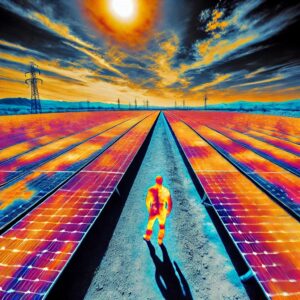
Every stakeholder in the solar utility industry—from investors and managers to maintenance teams—has a vested interest in the performance of their installations. Drones provide a powerful tool to address their concerns and optimize operations.
For investors, drone inspections offer a level of transparency and accountability that is often lacking in traditional methods. Detailed reports and high-resolution images provide clear evidence of a solar installation’s condition, helping to build confidence and ensure that investments are protected.
Managers can use drone data to plan maintenance schedules more effectively, ensuring that repairs are done quickly and efficiently. The ability to detect issues early also means that maintenance teams can be more proactive, addressing problems before they affect energy production.
Finally, for the maintenance teams on the ground, drones reduce the physical demands of their job, allowing them to focus on higher-level tasks rather than routine inspections. By automating the inspection process, drones free up time and resources that can be better spent on optimizing performance and ensuring the long-term success of solar installations.
Reference: Tools like DroneDeploy streamline the site assessment and inspection process, offering real-time data and improving collaboration among stakeholders.
Conclusion: A New Standard for Solar Panel Inspections
In an industry where efficiency and precision are paramount, drone technology is setting a new standard for solar panel inspections. 1UP Drones is at the forefront of this revolution, providing services that not only meet but exceed the needs of solar utility stakeholders. Whether you’re an operator looking to maximize ROI, a manager seeking to streamline maintenance, or a drone pilot eager to explore the latest technology, our services offer the perfect solution.
Contact 1UP Drones today to schedule your first inspection and start maximizing your solar farm’s efficiency—because in the world of renewable energy, every ray of sunlight counts.
Visit our website at www.1updrones.com, email info@1updrones.com or give us a call at 972-808-5185. 1UP Drones – Elevating drone utility services, one flight at a time! 1UP Drones is a proud subsidiary of American Infrastructure Group, Inc. (AIGI).
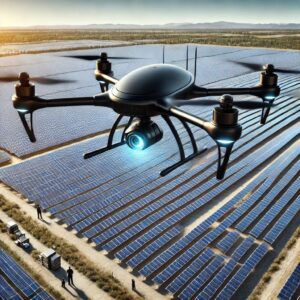
References
Vision Aerial. “Drone Solar Inspections: ROI.” August 21, 2023.
The Drone Life. “The Ultimate ROI Guide For Infrared Drone Solar Inspections.”
DroneDeploy. “Drone Solar Inspection | Renewable Energy.”
https://www.dronedeploy.com/solutions/renewable-energy
DARTdrones. “Drones for Utilities: Real-World Benefits, Use Cases and ROI.”

